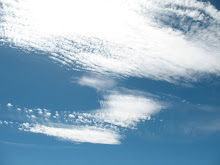
...when I rode into work this morning. It's still so dark outside, I can't see anything out of my office window. As many people know, I've launched a car-free lifestyle since July. Granted, my husband still owns a car, and I do ride in it sometimes, but in general, I'm getting around on foot, by bike or on the bus. Sometimes, I even get my husband and my daughter to do the same. It's been fun in the late summer, warm, light out. Often, I have take more scenic routes to or from work just to enjoy being out in the sun. This month, of course, the days started getting shorter. I had to steal my husband's headband work light to use as a headlight for my bike. That solved the darkness issue. Then, it got very cold, so I had to get some fingerless glove/mitten things. And now, the ultimate challenge - the rain. It's pretty intimidating at first. The idea of getting to work wet and cold in the morning doesn't appeal. I rode the bus the first half of this week, glad for the shelter and warm friendly faces on the bus.
(On an aside: there's a sweet old man on the bus who it turns out just rides it around and around all day to have someone to talk to).
But, I had to strengthen my resolve, get my act together and brave the storm on my bike. I went to Fred Meyer and got some super cozy rain clothes (50% off!). The pants are lined and padded and they have lots of zipped pockets to keep stuff dry. This morning, I put my work clothes in a water-proofed reusable bag my husband scored when he did some work at an eco-construction company (http://glumac.com/), and I headed off into the stormy darkness. It had occurred to me that I might want to ride without my glasses, but a blog I read from the Bicycle Transportation Alliance (http://www.bta4bikes.org/), said that glasses help keep the raindrops out of your eyes. And, well, yes that is true.
I have to say that it was a much more aerobic workout this morning, because I was in a hurry to get out of the wet and dark. I felt pretty studly walking into work with my slick biking clothes that went "squick, squick" when I walked. Then, I ducked into a bathroom stall like Superman to emerge in my jeans and "Save a tree for a better future" t-shirt. Of course, when I walked into the bathroom, I saw that someone had left the faucet on, which prompted an exhasperated, "Oh, who would do that?" But, so far, it's been an invigorating morning. The rain and the night have been conquered, at least for today. Hopefully, my bike chain won't rust in the many hours while I'm at work. It would be great if the bike chain fairy would stop by and squirt it with a shot of W-D 40. If it gets some rust, and my ride home is difficult, I'm sure I won't forget that part again.
















.jpg)









